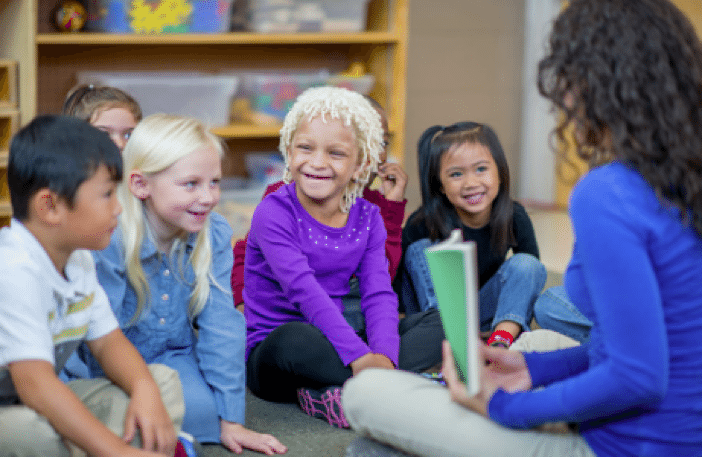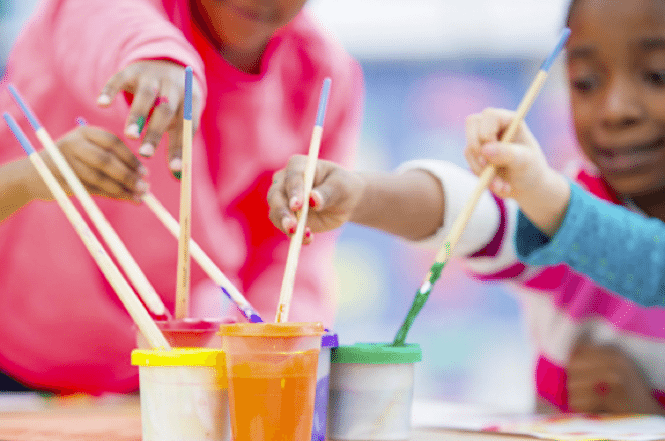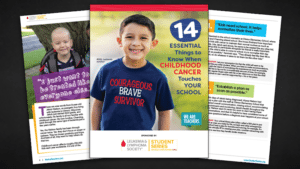Colds, sore throats, and stomach bugs are common afflictions among the school age set. A serious illness—one that requires prolonged and intensive treatment—is another story. Illnesses such as cancer affect the classroom community, and you’ll be called upon to support the affected student and family, as well as your entire class.
Here are 5 tips for broaching the conversation:
Involve the student and family.
What information would the family like to share with the class? Do they want to lead the discussion, or would they prefer that you do it? Or, is there a medical professional who is willing to talk to your class? (Some hospitals have child life specialists who routinely talk to school communities.)
“A diagnosis of cancer isn’t something that teachers need to announce to the other students,” says Brittney McGee, RN, a school nurse at West Elementary in McMinnville, Tennessee. “Let the child tell their classmates, or talk to the affected student about how they want you to talk about it. Let them have a voice.”
Some students want to be present during the conversation; others do not. Some don’t mind if information about their diagnosis is shared with the entire school; others want just a few close friends informed. Make sure you know what information is okay to share, and with whom.
Ask what they know.
Christy Hogan, a child life specialist at Children’s Hospital & Medical Center in Omaha, frequently begins conversations with classmates by asking, “What do you already know? What have you heard?”
That opening allows her to assess students’ baseline knowledge of the situation—and to correct any misconceptions. “They might have been told something, but perhaps it wasn’t accurate. Or maybe it wasn’t enough information for them to fully understand,” Hogan says.
Be direct and factual.
“I’ve found it’s really better to be upfront and honest,” McGee says. “When I talked to the classmates of a young boy who was diagnosed with leukemia, I said, ‘he has leukemia and it makes him feel sick sometimes. Sometimes he’ll need to come see me because he doesn’t feel well. He has to go get medicine to make him feel better. And cancer is not something you can catch.’”
You’ll need to adapt the words you use to your audience, but don’t shy away from words such as cancer, tumor or chemotherapy.
Younger students may benefit from visual aids. Kimberly Buff, founder of Momcology.com, a community for families dealing with childhood cancer, recommends the video Why, Charlie Brown, Why?, an animated Peanuts special that introduces a character who’s been diagnosed with cancer. (You can watch the full series on YouTube.) Hogan, the child life specialist, often uses a doll to with some medical devices attached (such as a central IV line) to show younger students what to expect when they see their classmate.

Encourage empathy.
Hogan sometimes asks students to think about what it would be like if they were in their friend’s shoes. This exercise, she says, not only allows students to express their own fears but helps students develop and express empathy for their classmate. A student who realizes she might feel scared in a similar situation is more likely to be sensitive to her classmate’s fears.
Another way to encourage empathy is to invite students to share their own experiences with serious illness. Sadly, nearly every family has been touched by cancer or another illness. So when a student in Jake Steger’s class was diagnosed with brain cancer, Steger, a teacher at Mayville Middle School in Wisconsin, shared stories of dealing with his father’s cancer. Bringing up his personal experience, Steger says, helped students feel more comfortable sharing their own stories—and sharing their stories allowed the class to see common threads, including feelings of helplessness, concern and compassion.
Talk about how they can help.
Children, just like adults, don’t like to feel helpless. When students learn that a classmate is facing a serious situation, they may want to channel their concern into concrete activity.
Mayville Middle School teachers Wendy Rheineck and Laura Hurtienne say their class’s first reaction to news of a fellow student’s cancer battle was always, “What can we do?” Rheineck and Hurtienne brainstormed with their class and supported the students’ efforts. “They made posters, banners, cards and so much more,” Rheineck says. “A group of girls formed ‘Team Alexis’ and raised over $350 to purchases gifts, including a TV, to make her more comfortable.”
Talk about simple things students can do too, such as using hand sanitizer frequently in the classroom, consistently covering their mouths and noses if they sneeze and working together to keep the classroom as clean and germ-free as possible. These “small things” make a big difference to a student who may be immune-suppressed and susceptible to illness due to medical treatment.
Finally, keep the lines of communication open. Students’ reaction to a serious diagnosis will vary and may evolve over time. Answer student questions, be open to their expressions of emotion and work together to support one another.

Get more great resources for teachers. Download our FREE GUIDE, 14 Essential Things To Know When Childhood Cancer Touches Your School.


